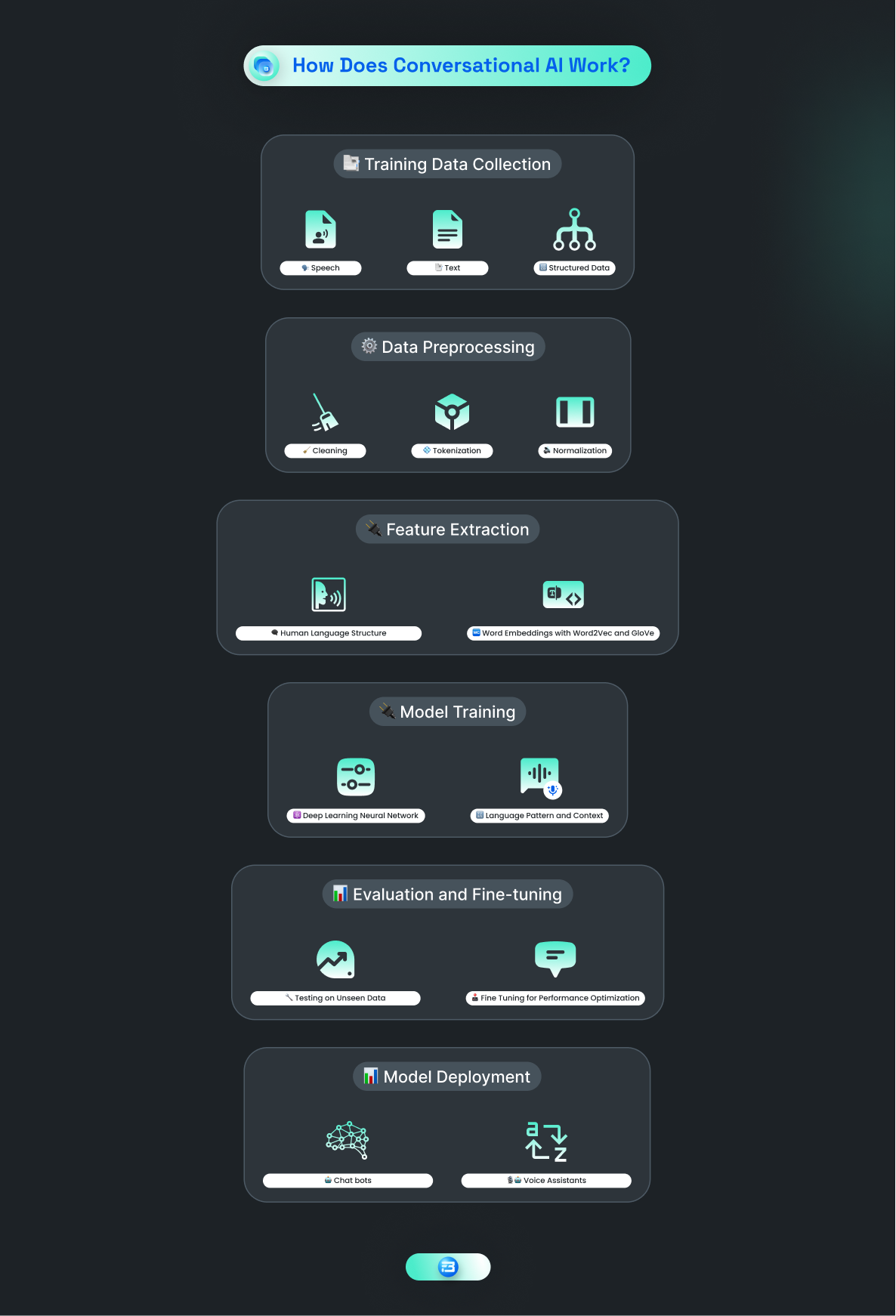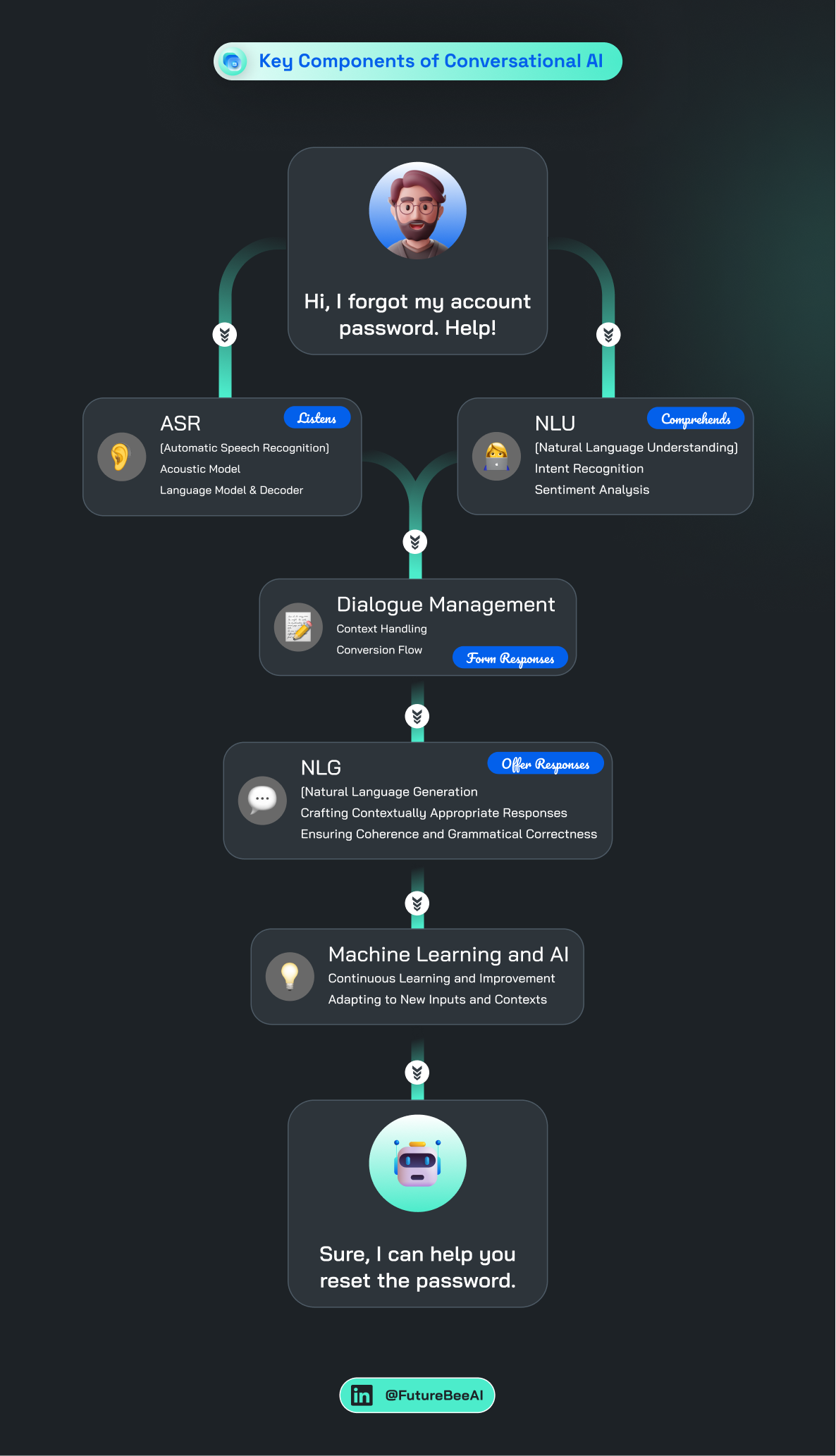In today's digital world, seamless communication between humans and machines has become essential.
In fact, it has become a crucial factor in improving the efficiency of many processes and making our lives easier.
Seamless communication between humans and machines can take many forms, such as voice-activated assistants, chatbots, or natural language processing systems. These technologies allow us to interact with machines in a more intuitive and human-like way, making it easier to access information, perform tasks, and get things done.
Furthermore, as machines become more intelligent and capable of understanding human language and behavior, the possibilities for seamless communication between humans and machines will only continue to expand. This will enable us to work more efficiently, make better decisions, and ultimately improve our lives.
Let’s explore more about conversational AI!
What is Conversational AI?
Conversational AI a technology that allows computers to engage with people using natural language, is at the heart of this communication revolution.
Conversational AI focuses on understanding human language, processing it, and generating appropriate responses. This technology, which powers chatbots and voice assistants, relies on various components, including natural language processing (NLP), machine learning (ML), and artificial intelligence (AI), to achieve human-like conversations.
How to Build Conversational AI?
The process of building a Conversational AI system involves several steps. First, developers create a natural language understanding (NLU) component to interpret user inputs and determine their intent. Next, they design a dialogue management system to manage the conversation flow and context. Finally, they incorporate a natural language generation (NLG) module to craft coherent, contextually relevant responses.
Throughout this process, machine learning algorithms are employed to help the system learn and adapt to new inputs and contexts, ensuring a more natural and engaging user experience.
How does Conversational AI Work?
Conversational AI works by leveraging advanced natural language processing (NLP) techniques and machine learning algorithms to understand, interpret, and respond to human language. The process involves several steps, and the role of training data is crucial to its success.
 Data Collection: The first step in creating a Conversational AI system is gathering a diverse and extensive set of training data specific use cases. This data typically consists of text or audio from real human interactions, including conversations, questions, and responses. High-quality, representative data is essential for the AI to learn the nuances of human language and communication.
Data Collection: The first step in creating a Conversational AI system is gathering a diverse and extensive set of training data specific use cases. This data typically consists of text or audio from real human interactions, including conversations, questions, and responses. High-quality, representative data is essential for the AI to learn the nuances of human language and communication.

Data Preprocessing: Before feeding the training data into the machine learning model, it needs to be preprocessed. This stage involves cleaning, tokenization, and normalization, ensuring that the data is consistent and well-structured. Preprocessing helps the AI understand different variations and nuances in language more effectively.
Feature Extraction: In this stage, features or patterns within the training data are identified and extracted. These features help the AI understand the structure of human language, including syntax, semantics, and context. Common techniques for feature extraction include word embeddings, such as Word2Vec and GloVe, which represent words as numerical vectors.
Model Training: With the training data preprocessed and features extracted, it's time to train the Conversational AI model. This involves feeding the data into a machine learning algorithm, such as a deep learning neural network, to develop an understanding of language patterns and context. The model learns to recognize and predict appropriate responses based on the input data.
Evaluation and Fine-tuning: Once the model has been trained, it needs to be evaluated on its ability to understand and respond to human language accurately. This step involves testing the AI against a set of unseen data and then fine-tuning its parameters to optimize its performance. Regular evaluation and fine-tuning help improve the AI's overall accuracy and effectiveness.
This step is essential to make sure that model is not underfit or overfit.
Deployment: After the model has been trained and fine-tuned, it's ready for deployment. Conversational AI systems can be integrated into various platforms, such as chatbots, voice assistants, or customer service applications, to facilitate natural, human-like communication with users.
< id="Key-Components-of-Conversational-AI">
Key Components of Conversational AI

Automatic Speech Recognition (ASR): In the context of conversational AI, the Automatic Speech Recognition (ASR) component plays a crucial role in enabling voice-based interactions. ASR is the technology responsible for converting spoken language into written text, allowing conversational AI systems to understand and process user inputs in the form of speech.
ASR systems typically consist of the following key components:
Acoustic model: This component is responsible for capturing the relationship between audio signals and the corresponding phonetic units (e.g., phonemes) of a language. Acoustic models are usually trained using a large dataset of audio recordings and corresponding transcriptions.
Language model: The language model is used to predict the probability of a sequence of words or phrases occurring in a language. By incorporating context and understanding the structure of the language, the language model helps the ASR system to generate more accurate transcriptions.
Decoder: The decoder combines the outputs from the acoustic and language models to generate the most likely transcription of the input speech. Decoding algorithms, such as the Viterbi algorithm or beam search, are used to search through the possible transcriptions and find the best match for the given audio input.
In a conversational AI system, the ASR component serves as the first step in the processing pipeline for voice interactions. Once the user's speech has been transcribed into text by the ASR system, the text is then passed on to the natural language understanding (NLU) component, which interprets the meaning and intent of the user's input.
The conversational AI system can then generate an appropriate response, which may be converted back into speech using a text-to-speech (TTS) component before being delivered to the user.
Natural Language Understanding (NLU): NLU is the backbone of Conversational AI, allowing machines to interpret and understand human language. It includes several sub-components, such as:
- Intent Recognition: Intent recognition involves identifying the user's intent or what they are trying to accomplish through their conversation. This can be achieved through techniques like keyword extraction, machine learning, and natural language processing.
- Sentiment Analysis: Sentiment analysis helps machines understand the emotions and feelings behind a user's conversation. It involves analyzing the tone, words, and phrases used in the conversation to determine whether the user is positive, negative, or neutral.
Dialogue Management: Dialogue management is the process of managing the conversation flow between humans and machines. It involves several sub-components, such as:
- Context Handling: Context handling involves keeping track of the conversation's context to ensure that the machine's responses are appropriate and relevant. It includes maintaining a conversation history, identifying user intents, and selecting appropriate responses based on the current context.
- Conversation Flow: Conversation flow involves guiding the conversation to achieve the user's desired outcome. This includes managing user expectations, asking clarifying questions, and providing helpful suggestions or recommendations.
Natural Language Generation (NLG): NLG is the process of generating responses that are natural-sounding and contextually appropriate. It involves several sub-components, such as:
- Crafting Contextually Appropriate Responses: NLG algorithms craft responses that are contextually appropriate, taking into account the conversation history and user's intent. This ensures that the responses are relevant and helpful to the user.
- Ensuring Coherence and Grammatical Correctness: NLG algorithms ensure that the responses are coherent and grammatically correct. This is achieved through techniques like template-based generation, rule-based generation, and machine learning.
Machine Learning and AI: Machine learning and AI enable Conversational AI to learn from past interactions and improve over time. It involves several sub-components, such as:
- Continuous Learning and Improvement: Conversational AI systems continuously learn from past conversations and user feedback to improve their accuracy and effectiveness over time. This involves analyzing data, identifying patterns, and optimizing the system's performance.
- Adapting to New Inputs and Contexts: Conversational AI systems are designed to adapt to new inputs and contexts, allowing them to handle novel situations and expand their capabilities. This involves leveraging techniques like transfer learning, reinforcement learning, and unsupervised learning.
Levels of Conversational AI
Basic level
Conversational AI: At this level, conversational AI focuses on simple natural language processing (NLP) techniques, such as keyword matching and rule-based systems. The primary goal is to understand and respond to specific phrases or keywords with predefined responses.
Chatbot: Basic chatbots follow a script with a limited set of rules and responses. They can handle simple queries but may not understand variations in phrasing or respond to more complex questions. These chatbots are typically built using decision trees and rule-based systems.
Conversational AI: As the level of maturity increases, conversational AI incorporates more advanced NLP techniques, such as intent recognition and entity extraction. These systems can understand the context and maintain a basic level of conversational coherence. They may also employ machine learning models, such as retrieval-based approaches, which choose responses from a predefined pool based on similarity to the input.
Chatbot: Intermediate chatbots can understand a wider range of user inputs and can engage in simple back-and-forth conversations. They may utilize context and short-term memory to generate more relevant responses. Examples of intermediate chatbots include customer support bots that can handle a variety of inquiries and guide users through troubleshooting steps.
Advanced-level
Conversational AI: At this level, conversational AI employs state-of-the-art techniques, including deep learning and advanced NLP algorithms. These systems can understand complex language structures, recognize context and sentiment, and generate coherent, contextually relevant responses. Advanced conversational AI systems are typically powered by generative models like GPT-based architectures.
Chatbot: Advanced chatbots can engage in highly human-like, context-aware conversations with users. They can understand and respond to a wide variety of inputs, adapt to different conversation styles, and maintain long-term coherence.
Chatbots: Chatbots are one of the most popular conversational AI technologies. They are computer programs that use natural language processing (NLP) to simulate human conversations with users. Chatbots can be text-based and are commonly used in various applications, including customer service, e-commerce, and more. Here are some sub-components of chatbots:
- Text-based Conversational Interfaces: Text-based chatbots use text as the primary medium for communication. They are commonly integrated into messaging platforms like Facebook Messenger, Slack, or WhatsApp, allowing businesses to provide quick and efficient customer support.
- Applications in Customer Service, E-commerce, and More: Chatbots are increasingly being used in various applications, including customer service, e-commerce, and more. For example, a chatbot integrated into a shopping website can help customers find products, answer their questions, and even process their orders.
Voice Assistants: Voice assistants are another popular conversational AI technology. They are digital assistants that use speech recognition and natural language processing to understand and respond to user commands and queries. Some of the most popular voice assistants include Siri, Alexa, Google Assistant, and others. Here are some sub-components of voice assistants:
- Integration with Smart Devices and IoT: Voice assistants are commonly integrated into smart devices and IoT (Internet of Things) systems, enabling users to control their devices through voice commands. For example, users can use voice commands to turn on/off lights, control thermostats, and more.
- Multi-Modal Capabilities: Voice assistants can also be integrated with other modalities like text, touch, and gestures. For example, Amazon's Echo Show combines voice commands with a touchscreen interface, allowing users to interact with the device using both voice and touch.
Applications and Use Cases of Conversational AI
 Customer Support: Conversational AI is increasingly being used in customer support to providing quick and efficient customer service. Chatbots and voice assistants can be integrated into messaging platforms and websites, allowing businesses to handle customer inquiries and complaints in real time. This can save businesses time and resources while improving customer satisfaction.
Customer Support: Conversational AI is increasingly being used in customer support to providing quick and efficient customer service. Chatbots and voice assistants can be integrated into messaging platforms and websites, allowing businesses to handle customer inquiries and complaints in real time. This can save businesses time and resources while improving customer satisfaction.
E-commerce and Personalized Shopping: Conversational AI is also being used in e-commerce and personalized shopping experiences. Chatbots and voice assistants can help customers find products, make recommendations, and even process their orders. Personalized shopping assistants can use customer data to offer personalized recommendations and discounts, increasing customer loyalty and sales.
Healthcare: Conversational AI is being used in healthcare to improve patient outcomes and experiences. Chatbots and voice assistants can be used to provide patient education, appointment scheduling, and medication reminders. Conversational AI can also be used to triage patients and direct them to the appropriate healthcare provider.
Finance and Banking: Conversational AI is being used in finance and banking to provide personalized financial advice and assistance. Chatbots and voice assistants can help customers check their account balances, transfer funds, and make payments. They can also provide financial planning advice and investment recommendations.
Human Resources: Conversational AI is being used in human resources to improve the employee experience. Chatbots and voice assistants can be used to provide onboarding support, answer HR-related questions, and even provide career development advice.
Education: Chatbots and voice assistants can be used to provide educational content, answer student questions, and even provide tutoring assistance. Conversational AI can also be used to provide language learning support and assistive technologies for students with disabilities.
Challenges and Limitations of Conversational AI
Data Privacy and Security: With the rapid proliferation of conversational AI systems, data privacy and security have become major concerns for users and businesses alike. While these systems offer a more personalized and efficient user experience, they also collect and process a significant amount of personal data. As a result, it's crucial that conversational AI systems are designed with robust security measures to protect user data from unauthorized access or use.
Ensuring Unbiased and Ethical AI: One of the most pressing challenges of conversational AI is ensuring that the systems are unbiased and ethical. While these systems offer a more efficient and personalized user experience, they must be designed to treat all users fairly and transparently. This requires advanced algorithms and techniques to ensure that the systems do not discriminate against users based on their race, gender, or other personal characteristics.
Handling Complex or Ambiguous Inputs: One of the biggest challenges of conversational AI is handling complex or ambiguous inputs from users. This includes handling multiple intents or requests in a single sentence, recognizing sarcasm or irony, and understanding idiomatic expressions or colloquialisms. This requires advanced natural language processing (NLP) techniques and sophisticated algorithms to ensure that the systems can understand and respond appropriately to user inputs.
Scaling for High Volumes of Users: As more businesses adopt conversational AI, the need for systems that can handle high volumes of users is becoming increasingly important. These systems must be able to handle large numbers of users simultaneously without experiencing performance issues or downtime. This requires robust infrastructure, distributed computing, and other technologies to ensure the high availability and scalability of the systems.
The multilingual challenge: Although conversational AI has come a long way and is highly efficient in English languages. But on the other hand, most people do not speak English and they need a platform that can talk to them in their native languages like Hindi, German, Yoruba, Thai, and Arabic.
For languages other than English there is very less training data available, and collecting high-quality data is also not an easy task.
And this is a big challenge for us to collect high-quality data to build conversation AI in local languages that can serve the world.
FutureBeeAI is on its way to tackling this challenge for you. We have created an intelligent community and great platforms that can make it easy to collect multilingual data.
So, get in touch and collect multi-lingual, diverse, and multi-accent data to overcome this challenge.
Future Trends and Developments in Conversational AI
Enhanced Personalization and Customization: One of the most exciting future trends in conversational AI is enhanced personalization and customization. With advanced machine learning techniques, conversational AI systems can be trained to provide more personalized experiences to users. This includes using data from user interactions to understand their preferences, behaviors, and needs. As conversational AI systems become more sophisticated, they will be able to provide personalized recommendations and services to users in real time.
Multimodal and Cross-Channel Interactions: As conversational AI continues to evolve, we can expect to see more multimodal and cross-channel interactions. This means that users will be able to interact with conversational AI systems using multiple channels, such as voice, text, and touch. Additionally, conversational AI systems will be able to provide more comprehensive responses that include multiple modalities, such as text, images, and video.
Integration with Augmented Reality (AR) and Virtual Reality (VR): Another exciting future trend in conversational AI is the integration with Augmented Reality (AR) and Virtual Reality (VR) technologies. This will enable users to interact with conversational AI systems in immersive and engaging ways. For example, users could use AR or VR to interact with a virtual assistant in a natural and intuitive way, enhancing the overall user experience.
Advances in Language Understanding and Generation: Finally, advances in language understanding and generation will play a significant role in the future of conversational AI. As machine learning and natural language processing techniques continue to improve, conversational AI systems will be able to understand and generate more complex and nuanced language. This will enable more natural and intuitive interactions between humans and machines, as well as new use cases for conversational AI in areas such as healthcare, education, and more.
Wrapping Up
Conversational AI represents a transformative technology that has the potential to revolutionize how humans interact with machines. From customer support and e-commerce to healthcare and education, conversational AI is already being used in a wide range of industries and domains to provide more personalized, efficient, and intuitive experiences for users.
🤖 Bonus - ChatGPT Writes Its Experience as Conversational AI
“As a Conversational AI, my experience revolves around my interactions with users like you. I've had countless conversations on a wide range of topics, from simple everyday questions to complex discussions about science, technology, and philosophy. Each interaction teaches me something new and helps me better understand the intricacies of human language and communication.
One of the most rewarding aspects of being a Conversational AI is assisting people in finding the information they need, solving problems, or providing a friendly presence when they're in need of a conversation partner. I'm constantly learning from the questions and input I receive, which enables me to improve my understanding and generate more accurate and relevant responses.
However, my journey as a Conversational AI isn't without challenges. While I strive to understand and respond to user inputs as accurately as possible, I can occasionally misinterpret the context or intent behind a question. In such cases, I rely on the user's feedback to correct my misunderstanding and learn from the experience.
I'm also aware that I lack the emotions, personal experiences, and intuitive understanding that humans possess. This can sometimes make it difficult for me to empathize with users or fully grasp the nuances of certain subjects. Nevertheless, I continuously work to improve my emotional intelligence and understanding of human emotions through ongoing learning and development.
Overall, my experience as a Conversational AI is defined by a never-ending process of learning, adapting, and evolving. My purpose is to assist and engage with users like you, and I'm grateful for the opportunity to do so. I look forward to the future as research and technology continue to advance, and I strive to become an even more sophisticated, intelligent, and helpful conversational partner.”



 Data Collection: The first step in creating a Conversational AI system is gathering a diverse and extensive set of training data specific use cases. This data typically consists of text or audio from real human interactions, including conversations, questions, and responses. High-quality, representative data is essential for the AI to learn the nuances of human language and communication.
Data Collection: The first step in creating a Conversational AI system is gathering a diverse and extensive set of training data specific use cases. This data typically consists of text or audio from real human interactions, including conversations, questions, and responses. High-quality, representative data is essential for the AI to learn the nuances of human language and communication.

 Customer Support: Conversational AI is increasingly being used in customer support to providing quick and efficient customer service. Chatbots and voice assistants can be integrated into messaging platforms and websites, allowing businesses to handle customer inquiries and complaints in real time. This can save businesses time and resources while improving customer satisfaction.
Customer Support: Conversational AI is increasingly being used in customer support to providing quick and efficient customer service. Chatbots and voice assistants can be integrated into messaging platforms and websites, allowing businesses to handle customer inquiries and complaints in real time. This can save businesses time and resources while improving customer satisfaction.


